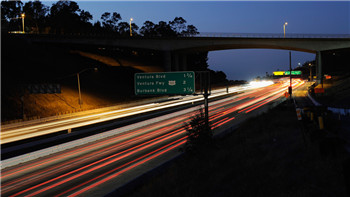
Brilliant technologies transform the magical into the banal.
卓越的科技会把神奇的东西变得平淡无奇。
An idea that seems outlandish to one generation becomes commonplace to the next.
曾经在一代人看来稀奇古怪的想法对于下一代人却变得稀松平常。
So it has been with electricity, space flight and the internet.
电力、太空航行以及互联网都是如此。
So it is likely to prove with driverless cars.
因此无人驾驶汽车可能也会如此。
The past few weeks have seen a flurry of announcements.
近几周这个领域接连传出许多消息。
Singapore has launched the world’s first public trial of a robo-taxi service.
新加坡展开了全球首项无人驾驶出租车的公开测试。
Uber and Volvo announced that they would pioneer an autonomous taxi fleet in Pittsburgh within weeks.
优步(Uber)和沃尔沃(Volvo)宣布,未来几周内,它们将率先在匹兹堡推出一支自动驾驶出租车车队。
Ford said it would build its first mass-market driverless car by 2021.
福特(Ford)表示,将在2021年前制造其首款面向大众市场的无人驾驶汽车。
To their backers, autonomous cars cannot arrive quickly enough.
对于支持者而言,自动驾驶汽车越快上路越好。
Conventional cars are inefficient, dangerous and dirty.
传统汽车低效、危险且肮脏。
They sit idle for 95 per cent of their lives, clogging up city streets and car parks.
它们有95%的时间在闲置,堵塞着城市街道和停车场。
When moving, they smash into each other, killing 3,500 people every day around the world.
在行驶中,它们会互相碰撞,全球每天有3500人死于交通事故。
Ninety per cent of accidents are caused by human error.
其中90%的事故是人为失误造成的。
Cars pollute the environment, accounting for 45 per cent of oil burnt.
汽车污染环境,占石油消耗总量的45%。
The widespread adoption of fully autonomous and, still better, electric cars could therefore be a massive boon to mankind.
因此完全自动化且质量更好的电动汽车得到广泛应用可能是人类的一大幸事。
It could lead to a far more efficient use of resources, save many lives and reduce congestion and pollution.
这可能会带来资源的更有效利用、挽救很多生命并减少拥堵和污染。
Futurologists envisage small fleets of shareable, connected cars constantly whizzing around our cities picking up passengers on demand.
按照未来学家的构想,一些由可分享的联网汽车组成的小型车队将时刻不停地绕着我们的城市飞驰,按照需求搭载乘客。
McKinsey forecasts that 15 per cent of new cars could be fully autonomous by 2030.
麦肯锡(McKinsey)预测,到2030年,15%的新车可能实现完全自动驾驶。
But two obstacles block their widespread adoption.
但有两个障碍因素阻碍着自动驾驶汽车的普及。
The first remains technological.
第一个仍然是技术上的。
For all the astonishing advances made in recent years, it is phenomenally difficult to replicate humans as sensory beings.
尽管最近几年这方面技术取得了惊人的进步,但要模仿人类打造具有感觉能力的自动驾驶系统是极其困难的。
How does a car distinguish between a plastic bag blowing across a road and a runaway dog? How does a car nudge its way through a throng of people outside a football stadium?
汽车如何区分一个被风吹过马路的塑料袋和一条奔跑的狗?汽车如何穿过足球场外拥挤的人群?
Engineers argue that the genius of self-driving cars is their connectedness.
工程师辩称,自动驾驶汽车的优势在于联网。
When human drivers make a mistake the individual learns from it, says one Silicon Valley pioneer. When a self-driving car makes a mistake then every other car will learn from a mistake once an engineer has fixed it.
当人类驾驶员犯错时,这个人会从中吸取教训,一位硅谷先驱表示,当一辆自动驾驶汽车犯错时,一旦工程师修复了这个问题,其他所有汽车都会相应改进。
It is just a matter of time before our technology surpasses human capacity.
科技超越人类能力只是早晚的事。
But sceptics compare autonomous car technology with Zeno’s dichotomy paradox: every leap will take us halfway to our destination without ever reaching it.
但怀疑者将自动驾驶技术比作芝诺(Zeno)的二分法悖论:每一步跳跃都是向着目的地走出剩余路程的二分之一,但永远不可能到达终点。
No matter how hard the technology proves, it may be the easier part of the puzzle.
不管事实证明要攻克技术有多难,它也可能是这个难题中较为容易的部分。
A stiffer challenge remains the human.
更为严峻的挑战仍然是人类。
Even when manufacturers and software engineers develop fully autonomous cars in which they have total trust, it will still take many years, if not decades, for them to be freely embraced by governments and consumers.
即便制造商和软件工程师开发出他们自己完全信任的全自动驾驶汽车,也需要花费多年、甚至几十年时间才能得到政府和消费者的安心接纳。
First, there is the instinctive human resistance to handing over control to a robot, especially given fears of cyber-hacking.
首先,人类天生反对将控制权交给机器人,特别是在担心黑客攻击的情况下。
Second, for many drivers cars are an extension of their identity, a mechanical symbol of independence, control and freedom.
其次,对于多数驾驶员而言,汽车是他们身份的延伸,是独立、控制和自由的机械象征。
They will not abandon them lightly.
他们不会轻易抛弃汽车。
Third, robots will always be held to far higher safety standards than humans.
第三,针对机器人总是要实施比人类高得多的安全标准。
They will inevitably cause accidents.
它们将不可避免的导致意外。
They will also have to be programmed to make a calculation that could kill their passengers or bystanders to minimise overall loss of life.
它们还必须经过编程做出可能导致乘客或行人死亡的计算,以将总体人员损失降至最低。
This will create a fascinating philosophical sub-school of algorithmic morality.
这将引发一个有趣的关于算法道德的哲学问题。
Many of us are afraid that one reckless act will cause an accident that causes a backlash and shuts down the industry for a decade, says the Silicon Valley engineer. That would be tragic if you could have saved tens of thousands of lives a year.
我们很多人担心一个冒失的行为将导致一场事故,进而这个行业会遭到抗议并被封杀10年,那位硅谷工程师表示,如果你原本可以每年挽救数万人的生命,那么这种结果将是一场悲剧。
Fourth, the deployment of autonomous vehicles could destroy millions of jobs.
第四,自动驾驶汽车的使用可能会葬送数百万个就业岗位。
Their rapid introduction is certain to provoke resistance.
这些汽车的快速引入肯定会遭遇抵制。
There are 3.5m professional lorry drivers in the US.
美国有350万名职业货车司机。
Fifth, the insurance industry and legal community have to wrap their heads around some tricky liability issues.
第五,保险行业和司法界必须埋头解决一些复杂的责任问题。
In what circumstances is the owner, car manufacturer or software developer responsible for damage?
在何种情况下,汽车所有者、汽车制造商或软件开发商要对损害负责?
Some governments, such as those of Singapore, China and the UK, as well as several states in the US are creating permissive regulatory and legal environments.
新加坡、中国和英国等一些国家的政府以及美国几个州正在创造宽松的监管和法律环境。
Regulators can certainly speed adoption by approving designated lanes for autonomous cars, for example, and devising international safety rules and standards.
监管机构无疑可以加速推动自动驾驶汽车的使用,比如说通过批准建设自动驾驶汽车专用道,以及制定国际安全规则与标准。
Conversely, politicians may yet succumb to the pressure of public fears and vested interests and frustrate the roll out of self-driving cars.
相反,政治人士仍可能屈服于公众担忧以及既得利益群体的压力,阻碍自动驾驶汽车的应用。
Autonomous car visionaries may soon be able to perfect the technology.
自动驾驶汽车的梦想家们可能很快就能完善技术。
But their success may be determined by how good they are — in Stalinist terminology — as engineers of human souls.
但他们能否成功可能取决于他们作为人类灵魂的工程师(用斯大林主义者的术语来说)有多优秀。












